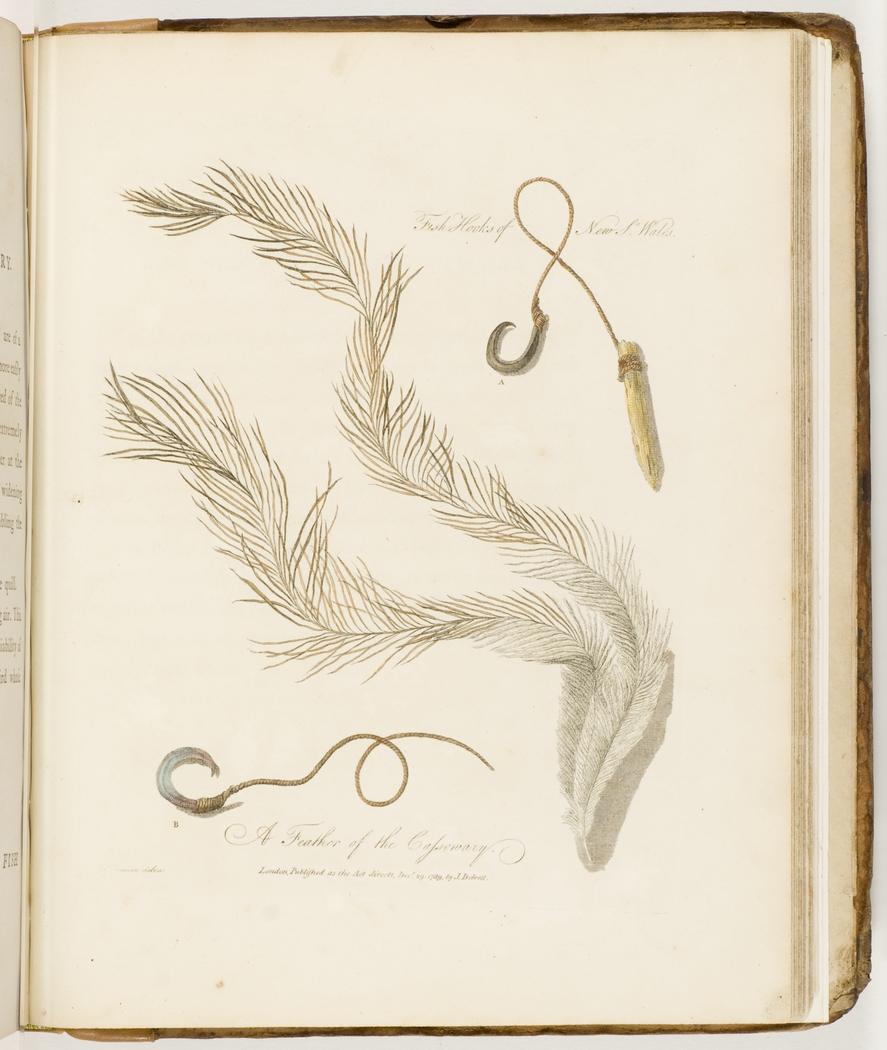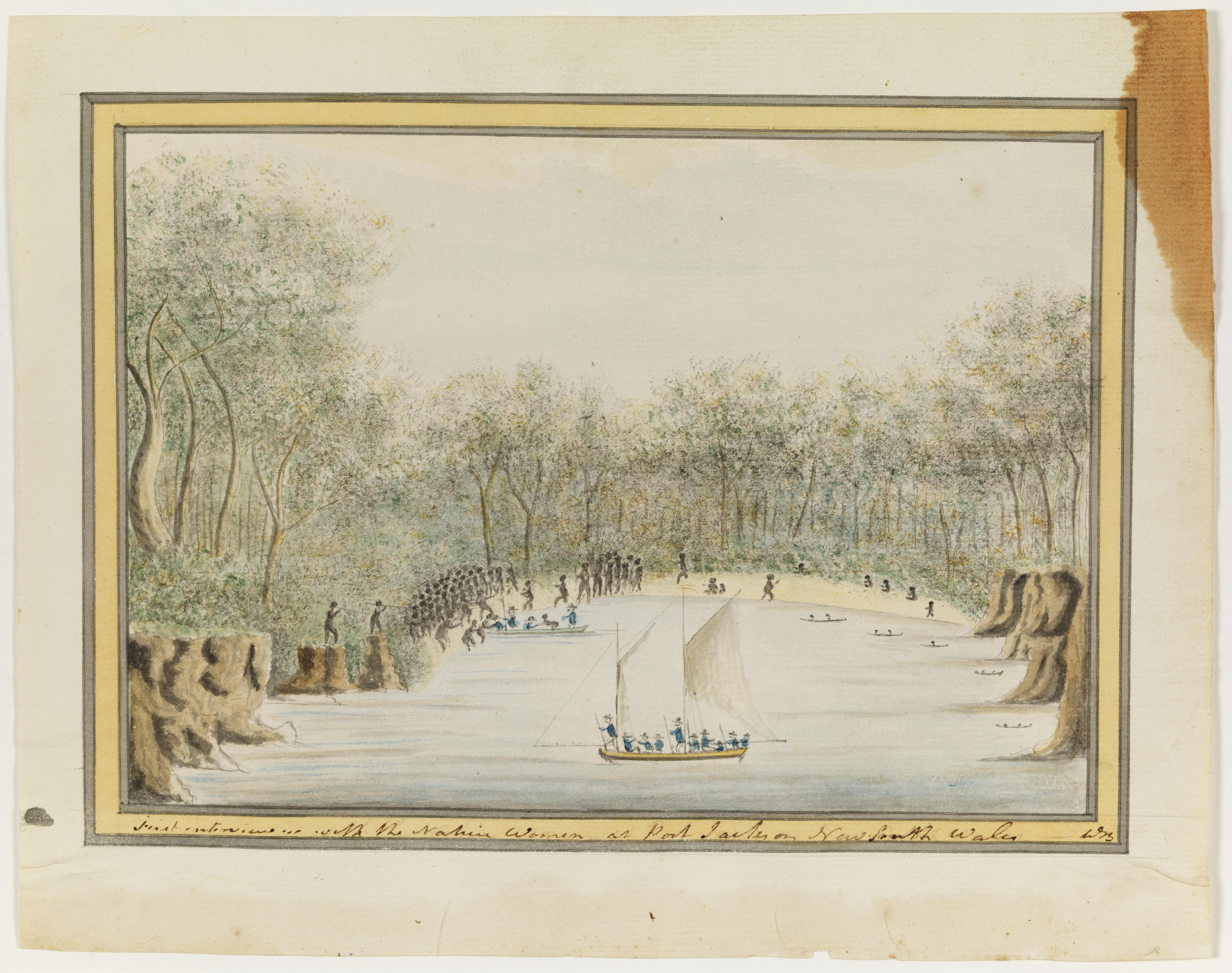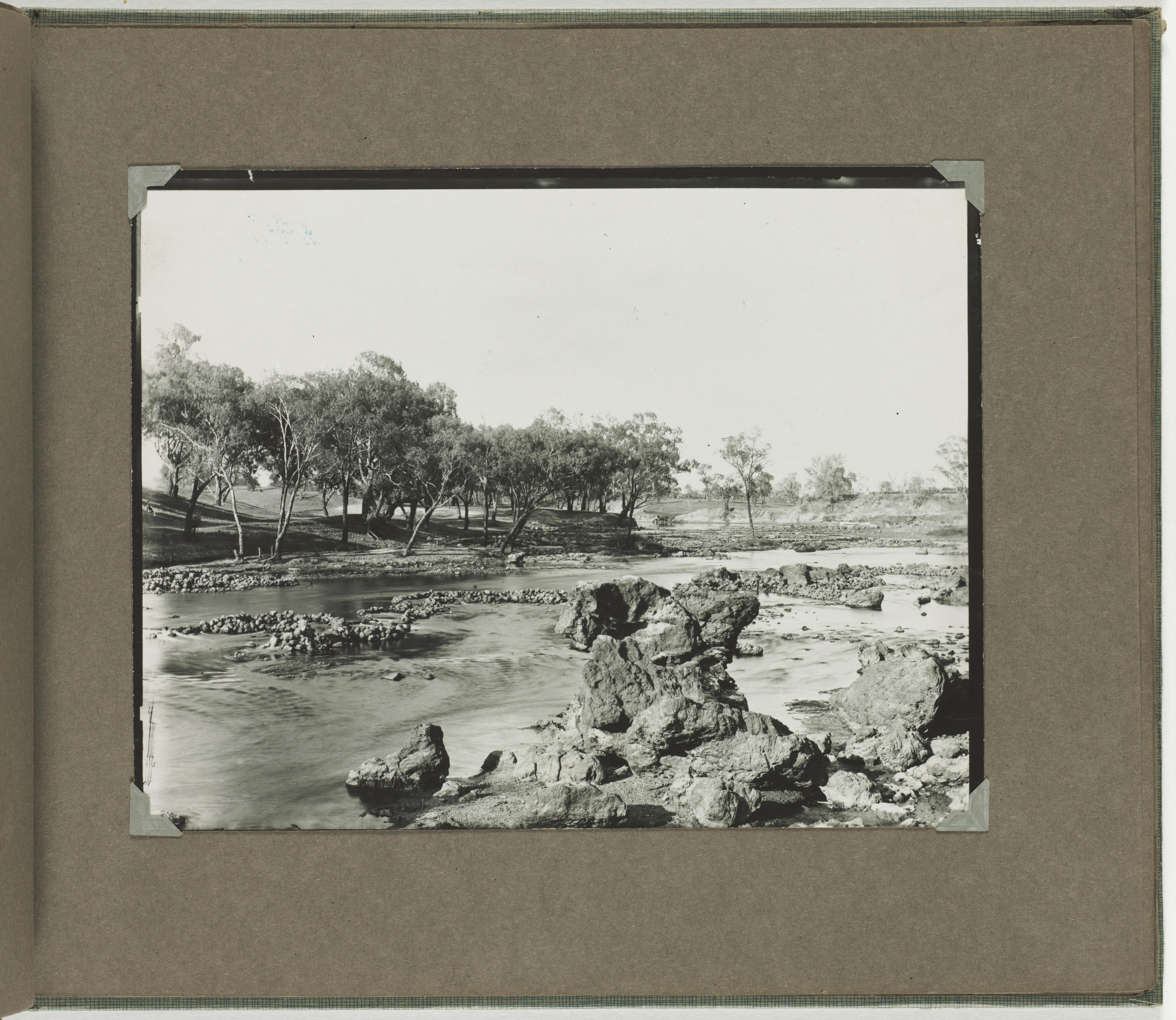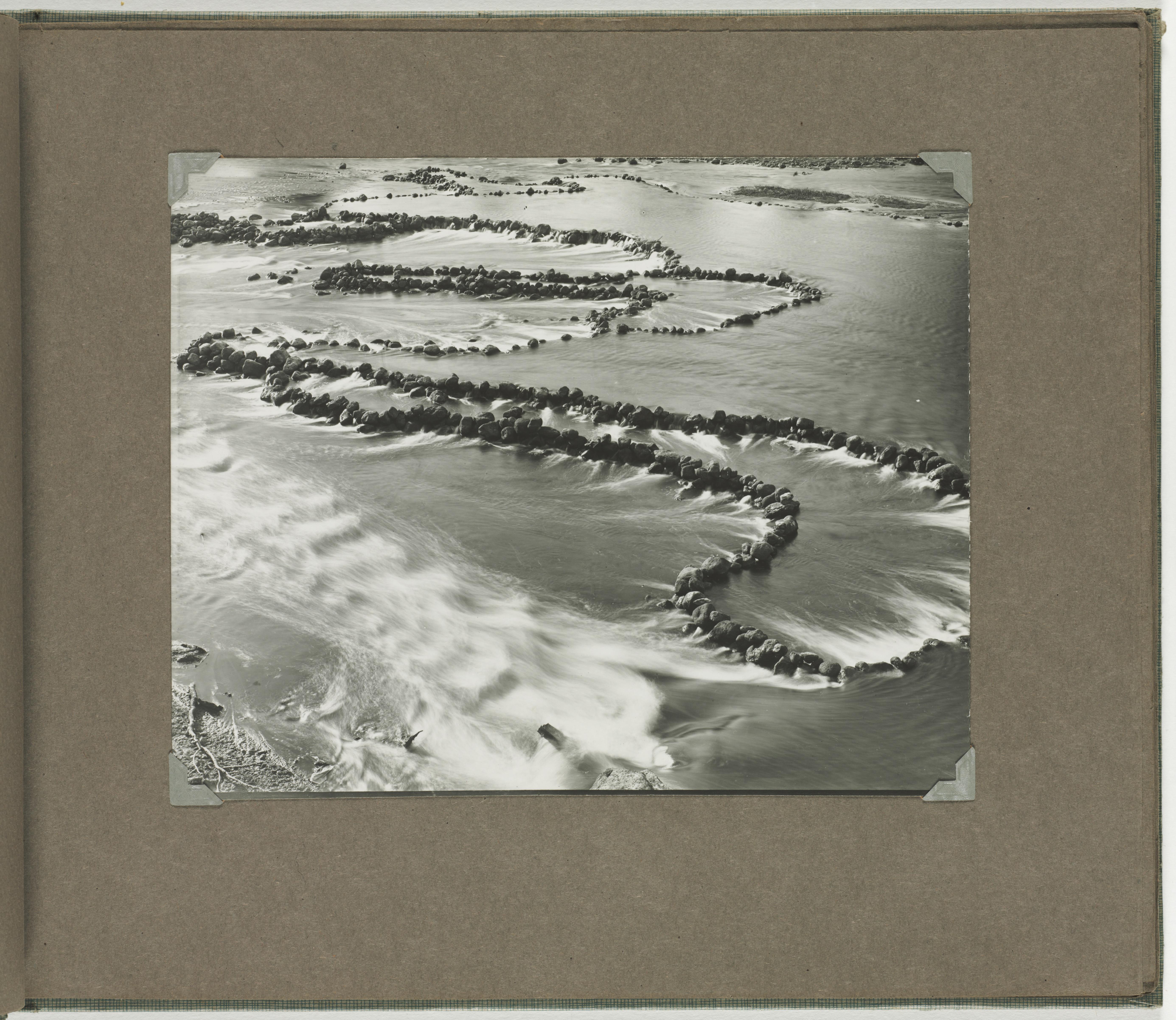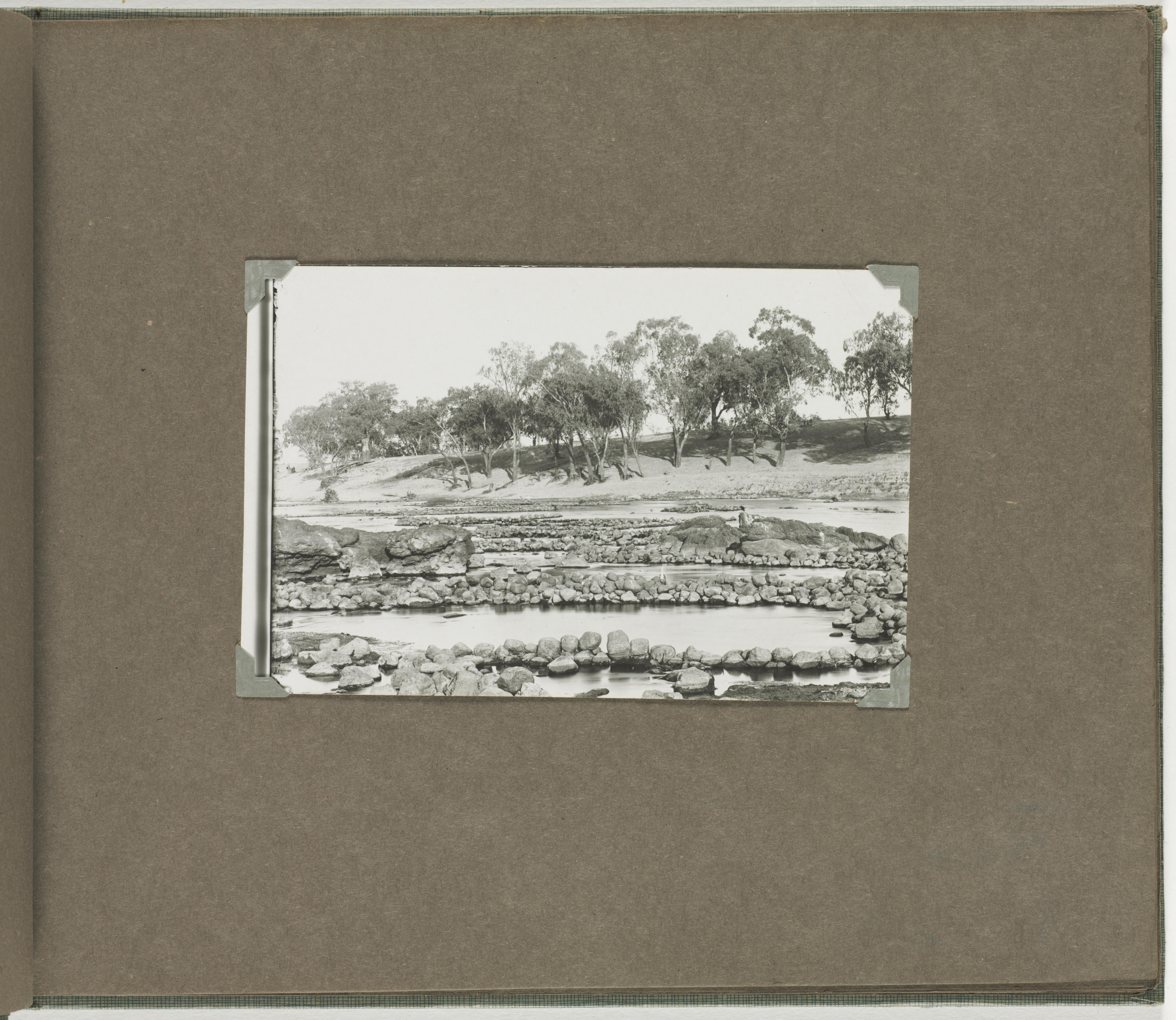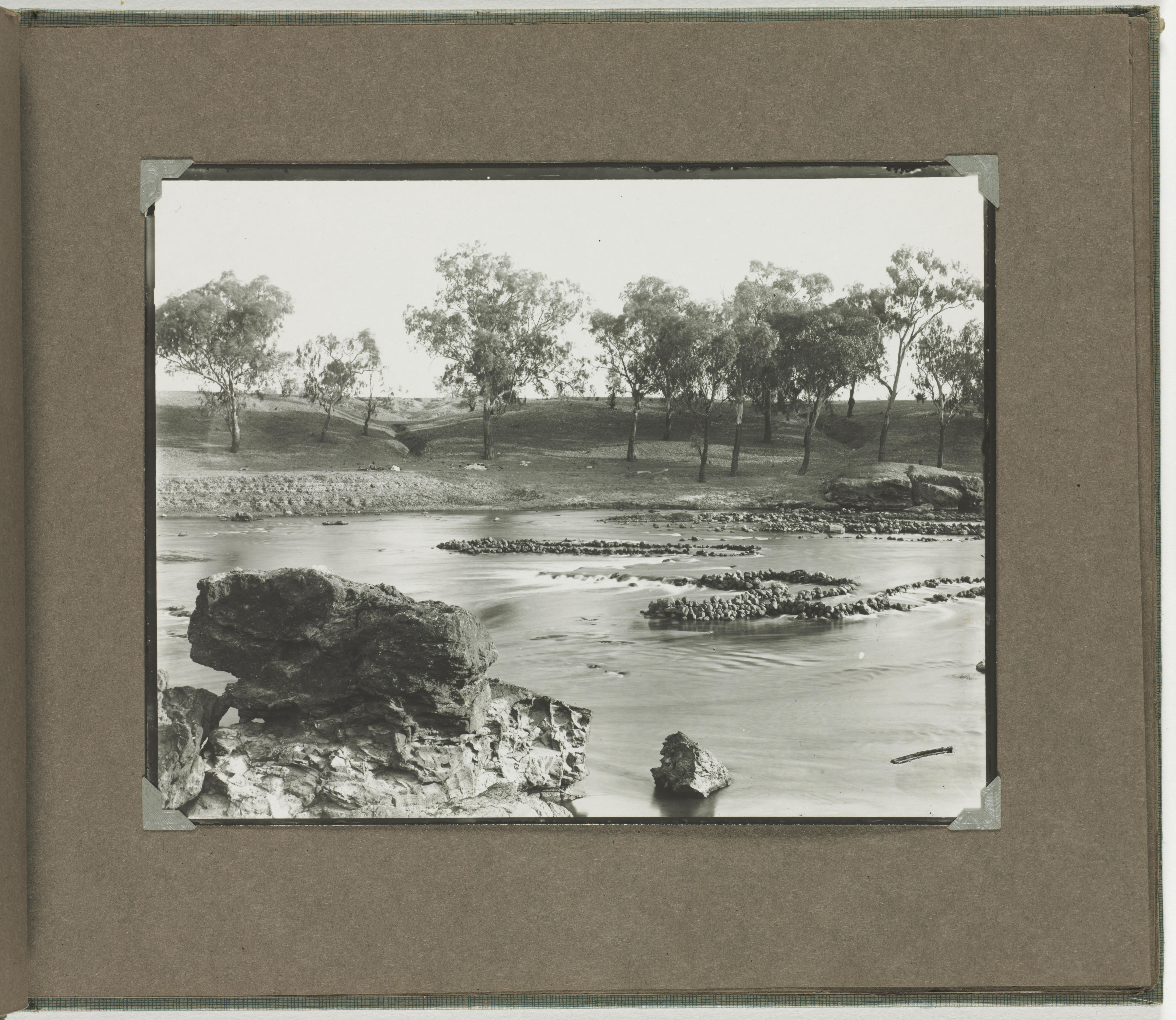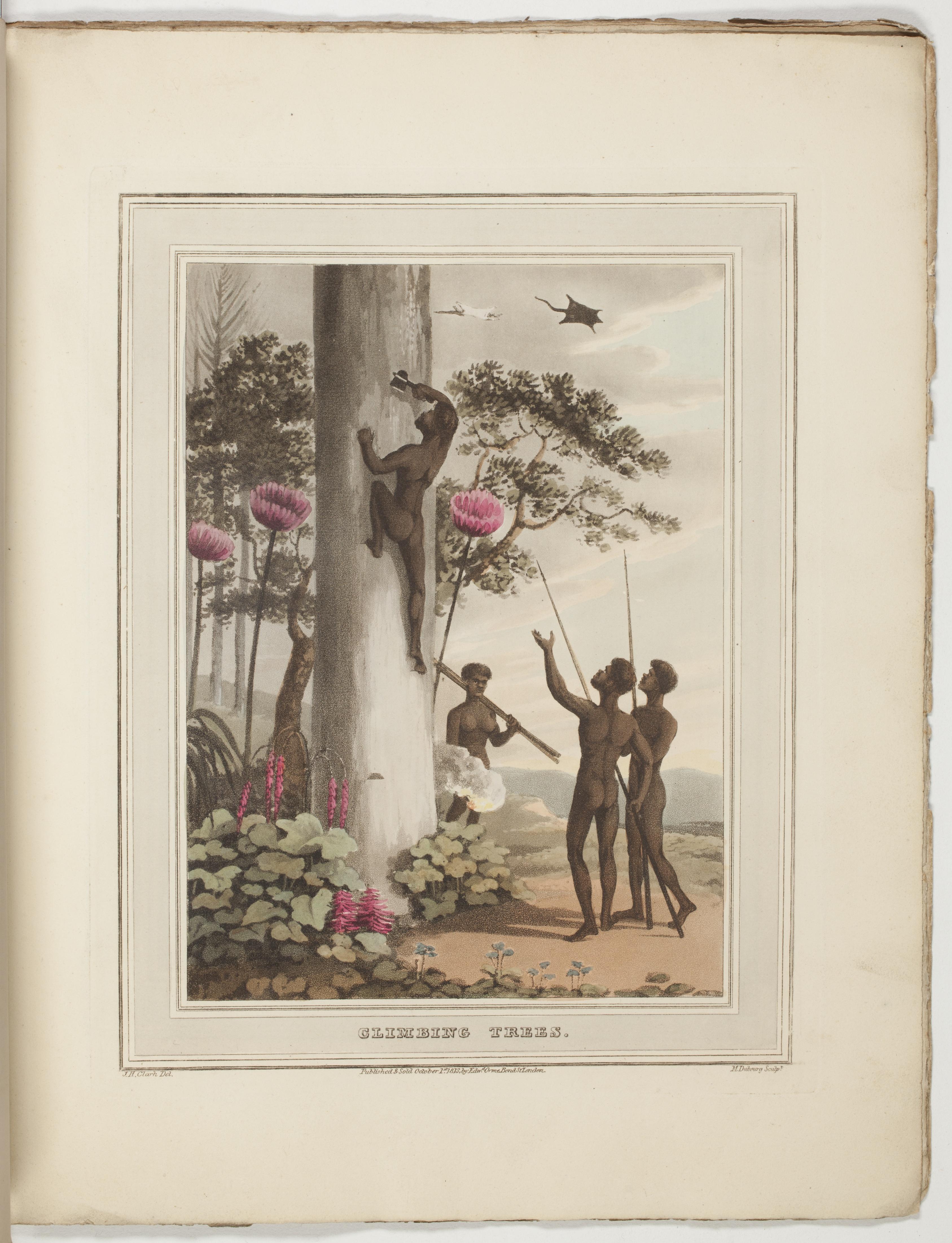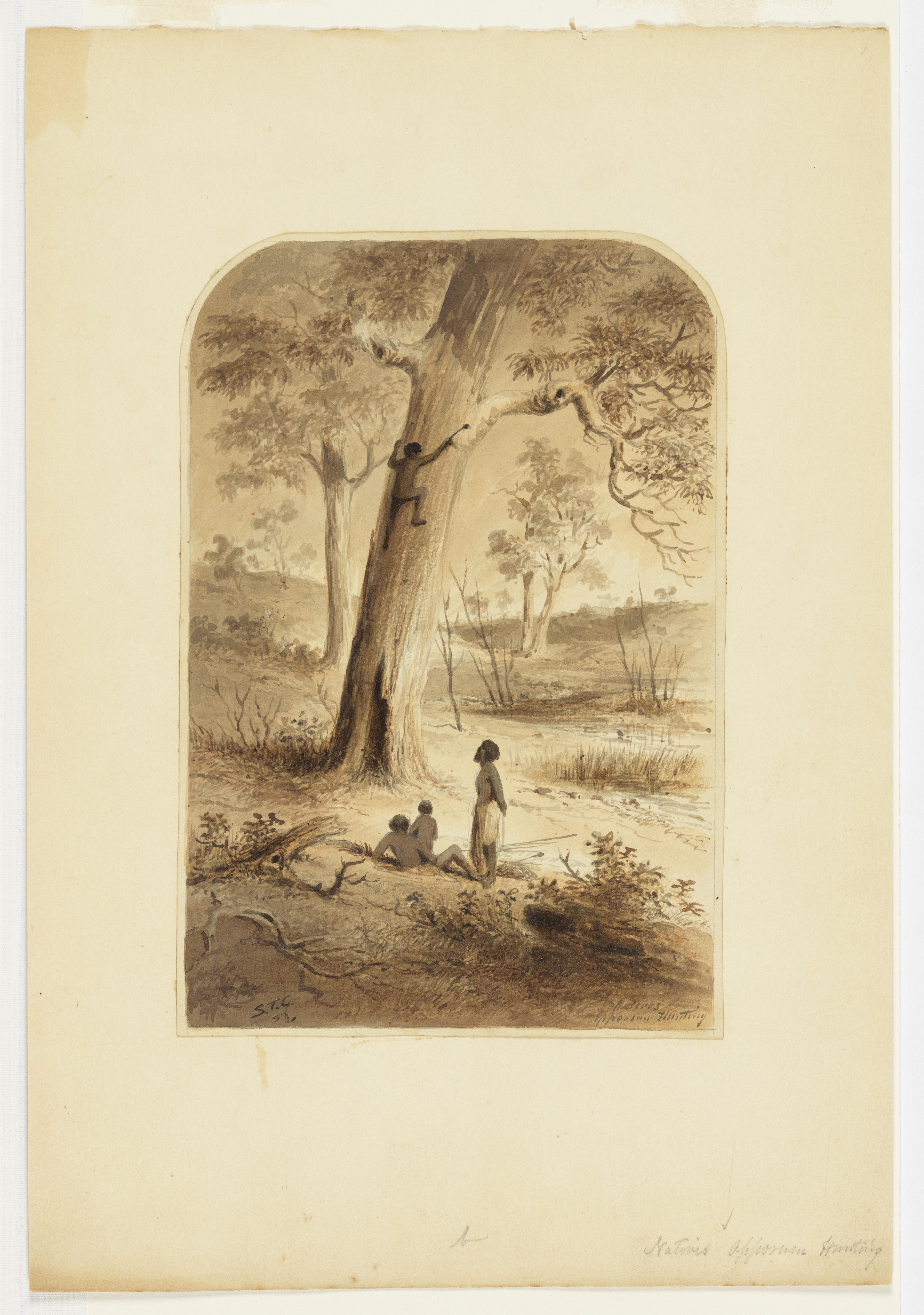Looking to learn
Students uncover the food sources and practices of Aboriginal people and look at the colonists’ response to local food.
This is the student activity 1 of 8 of the Food of the colony learning activity.
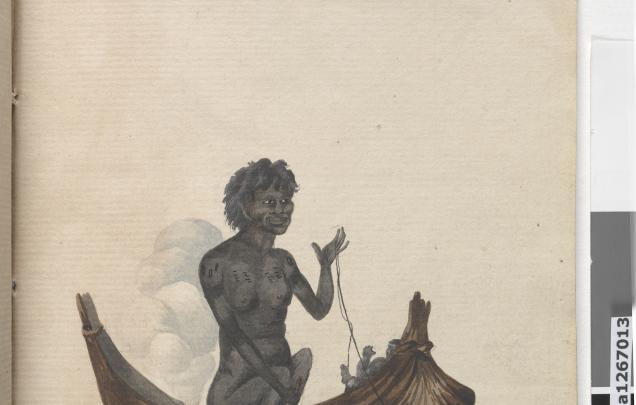
Looking to learn
There is evidence from the colonial primary sources that Aboriginal people were being watched and their methods of gathering food, cooking and eating habits were being recorded. Remember that these primary sources of information were written by sailors, soldiers, officers, doctors and government officials, almost all from Britain.
Read what Judge David Collins described in 1798:
At a certain season of the year…they subsist on eels which they procure by laying hollow pieces of timber into the water, into which the eels creep, and are easily taken. The woods…afford them but little sustenance; a few berries, the yam and fern-root, the flowers of the different banksia, and at times some honey, make up the whole vegetable catalogue. … make a paste formed of the fern-root and the large and small ant bruised together; in the season they also add the eggs of this insect.
Answer these questions:
- What does afford them but little sustenance mean?
- What does David Collins mean when he states that berries, yam and fern-root make up the whole vegetable catalogue?
- Did David Collins see every type of food the Aboriginal people were collecting or preparing?
- Is his record the full picture?
The Aboriginal peoples’ knowledge and understanding of all aspects of their natural environment - seasons, animal behaviours, hunting techniques and plant characteristics was immense. They developed and passed down an understanding of how these elements work together over 65,000 years and importantly their knowledge of sustainability was key to ensuring the land was kept in balance and the people had a healthy balanced diet. It appears that this enormous indigenous knowledge base and experience was not fully understood by the colonists of NSW.
Highly skilled hunting practices of the local indigenous people were observed by the colonists and recorded in words and images. Look at the painting of an Aboriginal man capturing his food, below.
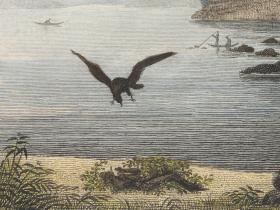
A similar method to this is confirmed by the 1798 account of Judge David Collins,
…take the following particular method to ensnare that bird: a native will stretch himself on a rock as if asleep in the sun, holding a piece of fish in his open hand; the bird, be it hawk or crow, seeing the prey, and not observing any motion in the native, pounces on the fish, and, in the instant of seizing it, is caught by the native, who soon throws him on the fire and makes a meal of him.
Aboriginal women were responsible for providing food for their families.
Look at the image of an Aboriginal woman, below.
Notice her fishing line, baby and fire in the nawi (canoe.) The nawi is made of bark from the outside of a tree.
Answer these questions:
- What was the fire for? [Answers in Additional Information.]
- How is it that the fire can be kept safe in a bark nawi? Remember that bark would be flammable. Brainstorm some ideas. [Answers in Additional Information.]
Aboriginal women had extraordinary skills in fishing, canoeing, swimming and diving. The women would fish in all weather and times of day as they were the main food providers for their families. They would sing as they paddled the water. Aboriginal fisherwomen were seen on the waterways of Sydney until the 1820s. The men used canoes to move across the harbour as transport and used multi-pronged spears to catch fish from the shore whilst keeping very still.
Read about Captain Watkin Tench’s experience on a boat in Port Jackson recorded in October 1790:
When we reached the opposite shore, we found Abaroo and the other woman fishing in a canoe…and Barangaroo sitting at the fire…employed in manufacturing fish-hooks.
Look at this drawing of handmade fishhooks published in Surgeon John White’s book published in 1790.
Research how these Aboriginal fish-hooks and fishing lines were made.
Barangaroo is mentioned in the above quote as being employed in manufacturing fish-hooks. So who was Barangaroo?
Barangaroo was an influential Camaraygal woman from Sydney’s north. She lost her husband and two children to the smallpox epidemic in 1789. When the officers first recorded her name in their journals in 1790 she was married to a younger man, Bennelong. As an older woman and one of the few survivors of the smallpox epidemic, Barangaroo was in a position to influence and teach younger Aboriginal women in the knowledge of Law and women’s rituals. She was proud of her culture and history and found ways to protect it.
Read a description of Barangaroo by Captain Watkin Tench in April 1791:
Barangaroo… was on this occasion… fierce and unsubmissive.
Define the words fierce and unsubmissive.
Barangaroo was a master fisherwoman and watched the newcomers using fishing practices that were opposite to her own. She would only catch enough fish for her families’ meal and use skill to catch fish one at a time. The colonists would catch as much as they could. Once she saw a catch of 4000 salmon hauled in by nets. A gift of 40 fish was presented to the Aboriginal men, which was more than their families could consume.
Look at the image below. The fish in the image are a leatherjacket and a salmon. Both types of fish were caught in Port Jackson and eaten by Aboriginal people before and during European settlement.
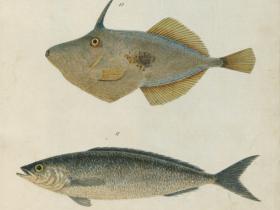
Answer these questions:
- How might Barangaroo have thought about the differences between the traditional ways of fishing and the practices of the colonists?
- What impact would the colonists’ fishing practices have on Barangaroo, her people and the environment?
Define sustainable.
Answer these questions:
- What might be the long-term impact of the colonists taking far more fish than they need?
- What made the Aboriginal people’s fishing practices sustainable?
- How do you think Barangaroo felt about the gift of fish to the men when Aboriginal women were the main food providers?
- Can you think of any situation where Barangaroo might need to be fierce and unsubmissive?
As a local Aboriginal fisherwoman Barangaroo would have been concerned at the depletion of the fish in the harbour as it impacted on the ability to feed her people. Watching nets bring in fish would have horrified her as she witnessed excessive numbers of fish being caught that couldn’t be eaten or stored. She was practiced in balancing the amount of food resources that were used.
Look at the painting, below, of the first meeting of officers and Aboriginal women in Port Jackson which was painted soon after arrival in 1788. Perhaps Barangaroo was there?
The officers commented on the skill of the Aboriginal women in handling their canoes whilst fishing and looking after the fire and babies. When the food supplies were very low and the colony was desperate for food, these men complained about not being able to catch enough fish as they had run out of fishing tackle.
Read Judge David Collins’ comment in May 1790 about how they obtained more fishing lines:
We were driven by necessity to avail ourselves of some knowledge which we had gained from the natives; and one of the convicts (a rope-maker) was employed to spin lines from the bark of a tree which they used for the same purpose.
Answer these questions:
- What were the colonists looking to learn from the Aboriginal people?
- What had made the colonists go to Aboriginal people for help?
- Do you think the colonists sought the advice of Aboriginal people often?
For more information on Aboriginal women at work, see Activity 4,Women at Work, of the Work to Be Done Learning Activity.
The fish traps
Aboriginal fish traps have been found across NSW. There is evidence that fish traps were used along the Hawkesbury/Dyarubbin River in north western Sydney by the Darag people. Fish traps were also used at Black Falls on the Nepean River in south west of Sydney.
Look at the photos, below, of the Brewarrina fish traps in NSW displaying Aboriginal aquaculture. The fish traps are called Ngunnhu by the local Ngemba people. These images can help us understand Aboriginal food practices in the Sydney region might have worked too.
Define the term aquaculture.
Notice the lines of rocks and stones in the water that would divert fish into holding ponds. The fish traps were carefully engineered constructions that could withstand floods and bad weather plus they did not obstruct the flow of the river. They were one of possibly hundreds built on inland rivers. If a large number of fish were required a trap was shut with a special keystone to keep the larger fish in but small fish could still get through to travel upstream and downstream.
The fish traps at Black Falls on the Nepean River in south west Sydney were built with logs as well as stones and traps on smaller tributaries are thought to have been made with twigs.
Read Bruce Pascoe’s explanation in his book Dark Emu: Aboriginal Australia and the Birth of Agriculture (2019):
Particular ponds in the system were managed and used by particular families – but those families had responsibilities for the secure provision of fish to the families upstream and downstream from their location.
Answer these questions:
- Why did Aboriginal people build fish traps?
- Why were families responsible to other families upstream and downstream?
- How did they do that? Explain how this system is sustainable food farming.
These fish traps were a sophisticated and permanent commitment to catching and farming fish. They would have been developed and improved over countless generations. An archaeological group have calculated that these fish traps at Brewarrina in NSW are 40 000 years old! They are part of the oldest continuous living culture in the world.
Gathering food
Besides fishing, other methods of gathering food by Aboriginal people were observed by officers exploring the area close to Dyarubbin/Hawkesbury River in 1789.
Read Lieutenant Bradley’s record of their expedition in June 1789:
Traps for catching Ducks great quantities of which were seen; they also had snares for taking Opossums & other Animals.
Read Captain Watkins Tench’s record of Aboriginal methods for catching animals from the same expedition in June 1789:
Sometimes in marks on trees which they had climbed; or in squirrel-traps; or… decoys for the purpose of ensnaring birds. These are formed of underwood and reeds, long and narrow, shaped like a mound raised over a grave; with a small aperture at one end for admission of the prey; and a grate made of sticks at the other: the bird enters at the aperture, seeing before him the light of the grate, between the bars of which, he vainly endeavours to thrust himself, until taken.
List the materials used in these different methods of catching animals. List the animals being caught as a food source.
Consider how much of the complexity and nuance of the work that Aboriginal people were doing may have been lost in translation. Often these accounts are the only primary sources describing Aboriginal culture.
Answer these questions:
- Can we rely on these primary to be accurate or unbiased?
- Are these primary sources telling us the whole story?
Look at the images, below, to understand why there were marks on trees.
Answer these questions:
- What are the marks on trees being used for?
- What tool is being used to make the marks on trees?
- In terms of food, what do you think is being caught up in the tree? [Answers in Additional Information.]
- What materials are the people using to catch animals?
- Where are those materials from?
Not everyone was impressed by the local food of NSW. The colonists were, on the whole, not keen to try new local food and rejected many options available to them. Many in the colony assumed that Aboriginal people were primitive and could not fathom that they might have better solutions than the British.
Read the following opinion.
Captain Watkin Tench’s thought in 1792:
The list of esculent vegetables, and wild fruits, is too contemptible to deserve notice… berries, destitute of flavour and nutrition.
Define the meaning of the words esculent, contemptible and destitute.
Answer these questions:
- Why has Watkin Tench used negative words to describe the local food?
- Does Watkin Tench know for certain that the local berries have no nutritional value? If not, who would know?
- What did the colonists learn from the Aboriginal people? Why?
Even though the colonists and the Aboriginal people were living side-by-side they were using different resources. Few of the plants being foraged by the colonists were the traditional food sources of the Aboriginal people. There was very little respect for the ways of Aboriginal people, and no understanding by the colonists that they were violently interfering in the oldest continuing culture on the planet.
Research native plants and resources in your area that Aboriginal people use as food sources. Draw these food sources as botanical illustrations labelled with their original (non-European) names.

